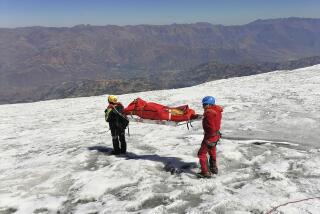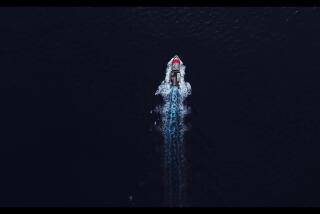Hijacker’s trail may be warming
- Share via
ARIEL, WASH. — In this damp, largely forgotten corner of the state, where loggers and former loggers live and drink in obscurity, the talk of the town has swirled around a dirt-stained clump of fabric recently unearthed not far from here.
It turned out to be part of a nylon parachute that roughly matched the dimensions of the one used by legendary hijacker “D.B. Cooper,” who leapt from a jetliner with $200,000 into folk-hero stardom 36 years ago. He is believed to have landed somewhere in this area. Neither Cooper nor his chute was found.
Until perhaps now. The FBI, which took custody of the chute, expects to have some answers this week. “Could be his, sure,” says Dona Elliott, owner of the Ariel Store, an old-time saloon and hangout for the 700 residents of this community 35 miles north of the Oregon state line.
“If it is, we’re going to have to have a party,” says Elliott, 71. Residents celebrate D.B. Cooper every year, regardless, right here at the Ariel Store. Last year’s party drew 260 people.
If this is D.B. Cooper country, the store is the unofficial capital. Inside the rustic confines is a virtual shrine to Cooper. Newspaper clippings and memorabilia tacked on the walls share space with mounted deer heads and bobcat skins.
“If it’s his, then the money must be around here, too!” says Ty Alsteen, 37, who has stopped in for a beer and nachos in the middle of the day. Alsteen’s comment elicits a murmur of excitement from others in the room.
The parachute could add one more piece to the puzzle whose pieces have come few and far between. FBI agent Larry Carr, in charge of the case, says the recent discovery is the first “significant lead” since he decided to “reenergize” the investigation in the fall.
This month, a couple of children playing outside their home found the fabric sticking out of the ground in a spot where their father had been grading a road. The kids and their father, over several days, dug out as much as they could, eventually cutting the fabric loose from the cords.
The kids, who had heard about the D.B. Cooper case, talked their dad into contacting authorities.
“If it weren’t for the kids, the father probably would have thrown it out with the trash,” Carr says.
It turned out to be a parachute canopy that generally matched the 26- to 28-foot-diameter chute believed to have been used by Cooper. He used a parachute system known in military circles as an NB6, kept by Navy pilots in case “they had to bail out of their aircraft,” Carr says.
The challenge, Carr says, was to find an expert who packed parachutes in the 1960s and early 1970s: “We have a lot of experts at headquarters, but we didn’t have one of those guys just sitting around.”
The expert the FBI did eventually find was to study the chute this weekend.
If the chute turns out to be compatible with an NB6 system, Carr says, investigators will take the search to a new level, perhaps excavating the site where the chute was found.
“We could go from zero to zero in one second or we could have a real piece of evidence,” Carr says.
The FBI calls it the only unsolved skyjacking in U.S. history.
On Nov. 24, 1971, a white man wearing sunglasses, a white shirt, narrow black tie, dark suit and raincoat -- and carrying a briefcase -- boarded Northwest Airlines Flight 305 in Portland, Ore. After the flight was underway, he told the crew there was a bomb in his briefcase and that he would detonate it unless he was given $200,000 and four parachutes.
The Boeing 727 landed in Seattle, where the passengers were released and authorities complied with Cooper’s demands. When the plane took off for Portland, only Cooper and the crew were onboard. About 45 minutes later, Cooper offered each of the flight attendants $2,000 as a tip, then opened a door in the back of the plane and jumped into the darkness and a driving rainstorm.
That was the last anybody reported seeing him. The name the hijacker provided when he bought his airline ticket was Dan Cooper -- which may not even have been his true name. After the skyjacking, a newspaper reported that police had interviewed an Oregon man named D.B. Cooper, who turned out to be the wrong man -- but the name stuck.
In 1980, an 8-year-old boy picnicking with his family along the Columbia River found a muddy wad of $20 bills totaling $5,800. Authorities confirmed that the money had been part of Cooper’s loot. The find bolstered the theory that Cooper was probably dead at the bottom of the river, but others speculated that he was clever enough to have placed the money in the river as a diversion.
The “decoy theory” is the one Elliott, back at the tavern, prefers. She says she believes Cooper survived, threw off searchers by dumping some of the cash, and went on to live a quiet life enjoying his small fortune. Perhaps even around here.
“Can’t prove anything, but that’s what I think,” says Elliott, who figures the guy pulled off a daring stunt, hurt no one and took the government for a couple of hundred thousand dollars. “Around here, we got a name for someone like that. Hero. And you’re invited to the next party.”
--
More to Read
Sign up for The Wild
We’ll help you find the best places to hike, bike and run, as well as the perfect silent spots for meditation and yoga.
You may occasionally receive promotional content from the Los Angeles Times.






